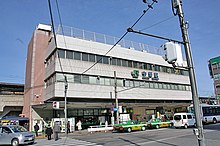Nakano Station (Tokyo)
JC06 JB07 T01 Nakano Station 中野駅 | ||||||||||||||||||||||||||||||||||||||||||||||
|---|---|---|---|---|---|---|---|---|---|---|---|---|---|---|---|---|---|---|---|---|---|---|---|---|---|---|---|---|---|---|---|---|---|---|---|---|---|---|---|---|---|---|---|---|---|---|
 The north entrance to Nakano Station in July 2012 | ||||||||||||||||||||||||||||||||||||||||||||||
| General information | ||||||||||||||||||||||||||||||||||||||||||||||
| Location | 5 Nakano, Nakano-ku, Tokyo Japan | |||||||||||||||||||||||||||||||||||||||||||||
| Operated by |
| |||||||||||||||||||||||||||||||||||||||||||||
| Line(s) | ||||||||||||||||||||||||||||||||||||||||||||||
| Platforms | 4 island platforms | |||||||||||||||||||||||||||||||||||||||||||||
| Tracks | 8 | |||||||||||||||||||||||||||||||||||||||||||||
| Connections | Bus terminal | |||||||||||||||||||||||||||||||||||||||||||||
| Other information | ||||||||||||||||||||||||||||||||||||||||||||||
| Station code |
| |||||||||||||||||||||||||||||||||||||||||||||
| History | ||||||||||||||||||||||||||||||||||||||||||||||
| Opened | 11 April 1889 | |||||||||||||||||||||||||||||||||||||||||||||
| Services | ||||||||||||||||||||||||||||||||||||||||||||||
| ||||||||||||||||||||||||||||||||||||||||||||||
| ||||||||||||||||||||||||||||||||||||||||||||||
Nakano Station (中野駅, Nakano-eki) is a railway station on the Chūō Main Line in Nakano, Tokyo in Japan, operated jointly by East Japan Railway Company (JR East) and the Tokyo subway operator Tokyo Metro.
Lines
Nakano Station is served by the JR East Chuo Line (Rapid) and Chuo-Sobu Line, and the Tokyo Metro Tozai Line. There are no turnstiles between lines, allowing for easy transfers.
Station layout



The station consists of four island platforms serving eight tracks.
Platforms
| 1 | JB Chūō-Sōbu Line | for Mitaka |
| 2 | JB Chūō-Sōbu Line | for Shinjuku, Akihabara, Kinshichō, Funabashi, and Chiba (originating at this station) |
| 3 | JB Chūō-Sōbu Line | for Mitaka (through trains from Tōzai Line) |
| T Tokyo Metro Tozai Line | for Otemachi, Toyocho, and Nishi-funabashi JB Sōbu Line (Local) for Tsudanuma TR Toyo Rapid Railway Line for Tōyō-Katsutadai (originating at this station) | |
| 4 | T Tokyo Metro Tozai Line | for Otemachi, Toyocho, and Nishi-funabashi JB Sōbu Line (Local) for Tsudanuma TR Toyo Rapid Railway Line for Tōyō-Katsutadai (originating at this station) |
| 5 | JB Chūō-Sōbu Line | for Shinjuku, Akihabara, Kinshichō, Funabashi, and Chiba (originating at Mitaka) |
| T Tokyo Metro Tozai Line | for Otemachi, Toyocho, and Nishi-funabashi JB Sōbu Line (Local) for Tsudanuma TR Toyo Rapid Railway Line for Tōyō-Katsutadai (originating at Mitaka) | |
| 6 | JC Chūō Line (Rapid) | for Tachikawa, Hachiōji, Takao JC Ōme Line for Ōme |
| 7-8 | JC Chūō Line (Rapid) | for Shinjuku, Ochanomizu, and Tokyo |
-
Platforms 1 and 2
-
Platforms 3 and 4
-
Platforms 5 and 6
-
Platforms 7 and 8
-
Station layout
Surrounding area
North side
- Nakano Ward office
- Nakano Sun Plaza, a major concert hall
- Sun Mall and Nakano Broadway, a shopping arcade famous as the home of Mandarake and for used record shops, collectibles, and other items
- Marui Department Store Headquarters
South side
- Nakano Zero, a cultural hall for concerts and exhibitions
- Nakano Public Library
History
Nakano Station opened on 11 April 1889.[1] The Tōzai Subway Line began operating from Nakano Station from 16 March 1966.[2]
Passenger statistics
In fiscal 2017, the JR East station was used by 148,789 passengers daily (boarding passengers only), making it the 21st-busiest station operated by JR East.[3] In fiscal 2013, the Tokyo Metro station was used by an average of 143,802 passengers per day (exiting and entering passengers). Note that the statistics consider passengers who travel through Nakano station on a through service as users of the station, even if they did not disembark at the station.[4] The daily passenger figures for each operator in previous years are as shown below.
| Fiscal year | JR East | Tokyo Metro |
|---|---|---|
| 1999 | 118,219[5] | |
| 2000 | 117,090[6] | |
| 2005 | 113,569[7] | |
| 2010 | 123,968[8] | |
| 2011 | 122,846[9] | 133,919[10] |
| 2012 | 125,025[11] | 136,994[12] |
| 2013 | 138,467[13] | 143,802[4] |
- Note that JR East figures are for boarding passengers only.
See also
References
- ^ JR East Nakano Station information Retrieved 10 March 2010. (in Japanese)
- ^ Terada, Hirokazu (July 2002). データブック日本の私鉄 [Databook: Japan's Private Railways]. Japan: Neko Publishing. ISBN 4-87366-874-3.
- ^ 各駅の乗車人員 (2017年度) [Station passenger figures (Fiscal 2017)] (in Japanese). Japan: East Japan Railway Company. Retrieved 4 May 2019.
- ^ a b 各駅の乗降人員ランキング [Station usage ranking] (in Japanese). Tokyo Metro. Retrieved 31 August 2014.
- ^ 各駅の乗車人員 (1999年度) [Station passenger figures (Fiscal 1999)] (in Japanese). Japan: East Japan Railway Company. Retrieved 3 September 2014.
- ^ 各駅の乗車人員 (2000年度) [Station passenger figures (Fiscal 2000)] (in Japanese). Japan: East Japan Railway Company. Retrieved 3 September 2014.
- ^ 各駅の乗車人員 (2005年度) [Station passenger figures (Fiscal 2005)] (in Japanese). Japan: East Japan Railway Company. Retrieved 3 September 2014.
- ^ 各駅の乗車人員 (2010年度) [Station passenger figures (Fiscal 2010)] (in Japanese). Japan: East Japan Railway Company. Retrieved 3 September 2014.
- ^ 各駅の乗車人員 (2011年度) [Station passenger figures (Fiscal 2011)] (in Japanese). Japan: East Japan Railway Company. Retrieved 3 September 2014.
- ^ 駅別乗降人員順位表(2011年度1日平均) [Station passenger figures (Fiscal 2011)] (in Japanese). Japan: Tokyo Metro. Retrieved 3 September 2014.
- ^ 各駅の乗車人員 (2012年度) [Station passenger figures (Fiscal 2012)] (in Japanese). Japan: East Japan Railway Company. Retrieved 3 September 2014.
- ^ 各駅の乗降人員ランキング (2012年) [Station usage ranking (2012)] (in Japanese). Tokyo Metro. Retrieved 3 September 2014.
- ^ 各駅の乗車人員 (2013年度) [Station passenger figures (Fiscal 2013)] (in Japanese). Japan: East Japan Railway Company. Retrieved 3 September 2014.
External links
35°42′22″N 139°39′56″E / 35.70611°N 139.66556°E
- JR East Nakano Station information (in English)
- Tokyo Metro Nakano Station information (in English)






